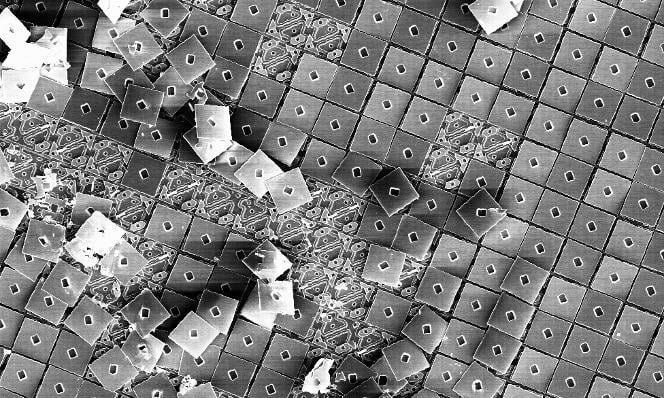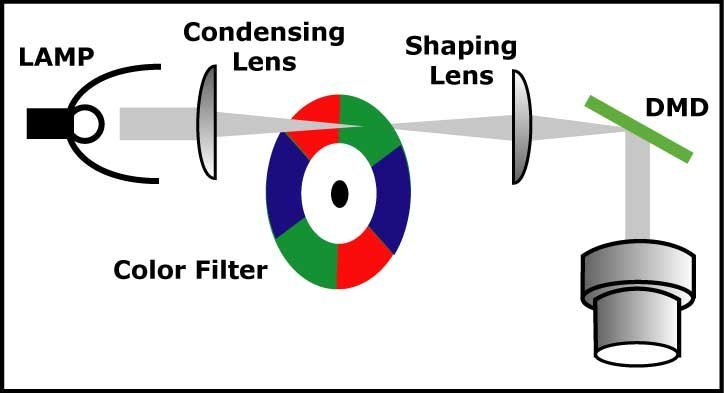The DMD is a chip that is designed to work on the basis of memory RAM (Random Access Memory), known by the use of computers. The chip has a series of tiny mirrors, one for each memory location. Each mirror is equivalent to a pixel. In the headlights with DMD chip 1920X1080 analysis, the mirrors are what and pixel (1920Ch1080 = 2.073.600).
Each mirror is located on a Nano-hinge and can be tilted right or left thousands of times a second.
Create image with DMD
How is the image?
Each mirror is one pixel of the image we see. The Tomb tells RAM in particular mirror every time activated or deactivated to show black or white on the screen. When the mirror reflects light to one side (towards the projector lens) then we see white on our monitor and when I reflect upon the other (in a light trap that exists inside the optic) then we see black.
The RAM memory can be changed thousands of times per second the mandate to the DMD, essentially forcing each tiny mirror vibrate with various speeds and creates in our display varying levels of light, the so-called levels of gray (grey scale).
A typical DLP projector that uses a single DMD chip displays 256 levels of gray.
Well as other here, talking about a black and white image to grayscale. What about color?
Create a color image with DMD chip
To add color to the image of a monotsipoy DLP projector, place a glass moving wheel consisting of various chromatic sections, called segments, which rotates between the lamp and DMD. To his name, color wheel (color wheel).
The most common color combination parts are red, green, blue and white (RGBW), primary colors RGB i.e., other there are many different types of color wheels for special applications (data, cinema, home cinema, etc.).
When all colors are represented with great frequency in the display, then our brain combines and seeing color image. The color wheel spins at speeds up to 2 x 6Ch per frame (that is 50 to 150 turns per second for PAL).
Brilliant chromatic Color wheels
For applications of the DMD as home cinema (films) do not use colour wheels RGBW philosophy other Brilliant Color. The color Brilliant Color wheels usually have six or seven chromatic sections. Usually red, green, blue, cyan, magenta, yellow (RGBCMY) and in some implementations and white (RGBCMYW)
These wheels are included as you may have noticed that the three primary colors RGB and the three secondary colors, CMY provision which enables DLP to produce more colours than other display technologies, including LCD/LCOS, SXRD using only red, green and blue (RGB) to create a color image.
The size of each color section of the wheel has to do exclusively with the intended use of the projector. DATA projectors have majority white in their wheel (for greater brightness) while the headlamps intended for viewing movies minimum or not at all.
Some examples
The advantages of a projector using DMD (DLP)
Size and simplicity of construction
DLP projectors are generally smaller and lighter than other technologies headlights without physically to lag in performance.
Grayscale & color fidelity
The exact reproduction of grayscale and color in DLP projectors are fixed for the entire lifetime of the DMD (20,000-50,000 hours) Unlike all other technologies that complicated visually wane over time by changing behavior in the medium projection.
Fill ratio
Due to electronic circuits that lie on the substrate of chip (behind the mirror), mirrors of DMD can lie very close together. This is not possible in LCD technology which requires the electronic circuits to lie between pixels (pixels). This leads to much smaller gap between pixels, ensuring picture compact and knit compared to other technologies.
Color convergence
DLP projectors use the same color for each pixel to create a color image. This means that there can be no wrong alignment as in LCD for color creation make use of three pixel aligned between them.
Lifetime
The DMD (used by DLP projectors) makes use of moving mirrors and cannot present the phenomenon of burn-in (ghosting) that can be created due to static image viewer for a long time, so it is suitable for any kind of heavy use.
Also the mirrors of DMD are not altered with time and use such as panels and the polarizers to LCD projector allowing to have the same color fidelity and brightness for the entire lifetime of the DMD (of course we exclude the aging of the lamp that is consumable and the necessity of cleaning optical per periods from the equation)
Unlike other technologies, the DMD is not affected by ultraviolet and infrared light of high-pressure bulb and did not incure any alteration such as LCD.
Motion
The mirrors of the DMD chip can run at very high speeds, and this translates into very high frame rate and fluid motion in the image. For this reason it is also ideal for viewing 3D material which need high frame rate.
High ansi contrast
Because animation technology mirrors, headlights that make use of the DMD chip with the ability to keep a high contrast when in frame of the film bright and dark coexist objects, unlike other technologies that these scenes are a general weakness.
AV Source Magazine
Nikos Tswlas






